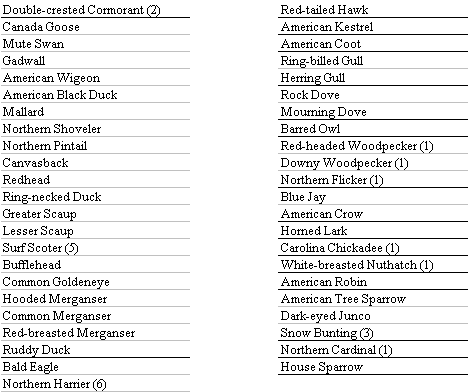Winter has its attractions when it is fresh and new. Then, we seek out species from the north, and it’s always interesting to find which half-hardy species tough it out. The gatherings of waterfowl and gulls in winter can be awe-inspiring in their numbers and variety. By February, however, these delights begin to grow a bit stale: the presence of winter finches is obvious (or not, as was the case this year), the gulls and the ducks have become routine, and we pretty much know which half-hardy birds have braved the season. Sure, goldeneyes have begun their charming courtship displays, a presumptuous woodcock or two might be calling, cranes should be moving, and late in the month we might see an early tree swallow or hear a winnowing snipe, but by and large February only prolongs winter’s deprivations.
Knowing all this, a lucky 13 of us gathered in 5° cold on the 8th to go birding (note that 5+8=13). Four were first-timers with the Avids. The skies were clear, the winds brisk out of the southwest at 13 mph. Omniscient leaders had determined that the general ice cover on Lake Erie would concentrate many interesting gulls at warm-water outlets along the shore as they had in previous weeks, and that these and the predictable daily schedule of roosting merlins at a Cleveland cemetery justified a trip to the northeast.
Our first stop, Avon Lake ’s power plant, richly deserves its reputation as the coldest spot in Ohio , but the Avids were bundled up, and spent over an hour sorting through the waterfowl that had settled into its plume of warm water. We had fourteen species of ducks and geese, a cormorant, a horned grebe (possible), and a mere handful of gulls. The wind hurried but did not dissipate the mist over the hot water, and the early light was brilliant. Fish were abundant in the shallows near the pier. We found five surf scoters among the mallards and scaups, and an apparent hybrid common goldeneye X hooded merganser transfixed us for quite a while. A man fishing from the pier beside us was pulling in one steelhead after another, demonstrating the abundance of food here for piscivores of many species. Nevertheless, our count of cormorants was one, that of gulls only six. Weird.
Surely gulls—only 10 days before numbering eight species or more, and abundant—would be thronging E. 72nd St. in Cleveland , and there we headed next. Cleveland , however, did not detain us long. Some of our more sybaritic members, seeing there were virtually no birds present, chose to stay inside their van and snack while the rest of us scanned long enough to establish the most interesting bird among the diving ducks present was a hybrid of greater scaup and ring-necked duck—interesting perhaps, but nothing compared to our high expectations for this near-legendary gull spot. The sybarites had passed their time wisely, reading the new Ohio Cardinal, interrupting this enlightenment long enough to spot the only gull we were to find here.
There was nothing to do but proceed, a little grimly now, to the next warm-water outlet, the Eastlake power plant. Here similar conditions prevailed: a broad ribbon of warm water wreathed in mist, several hundred waterfowl, ice to the horizon broken by a few unbirdy leads, and maybe a dozen and a half gulls. After determining that nothing new was present, we huddled and could foresee no profitable way to spend the 6.5 hours remaining till the merlins returned to their cemetery roost. Good February birding spots are few, and we eventually decided to abandon the Lake , cancel the appointment with the merlins, and head to Killdeer Plains, with a stop at Castalia along the way.
As always free-spirited, imaginative, and cavalier about sound advice, each of our four drivers followed a different route—and schedule—to Castalia, so some stayed longer than was necessary just to add five puddle duck species to the list. The only eagle of the day repeatedly reveled in his ability to make the carpet of geese stir and honk in alarm. More waterfowl hybrids were noted: a mallard X black duck, and very international Canada X Chinese goose. We began to wonder, however illogically, if the number of hybrids reflected the puny numbers of birds, as if the draining of the gene pool had made good mates hard to find.
Again, four refreshingly original and inventive routes were taken to our next spot, Killdeer Plains. The wind had picked up quite a bit, and a shrike search was abandoned as likely fruitless. No need to fret about harassing birds at the owl grove, as the only owl, a grumpy barred, was already under assault by blue jays when we arrived. Some very fine and well-informed plans were laid to scour the surrounding fields for longspurs and snow buntings while counting raptors. Fourteen miles of roads yielded only disappointing numbers of horned larks. As for counting raptors, that was easy, requiring only the regulation set of fingers. At a stop to verify there were no red-headed woodpeckers around, Steve found a set of what looked for all the world like bobcat tracks in the snow; inevitably, some interpreted this discovery as another gloomy reminder of animals that weren’t around just then.
One by one, carloads of Avids began peeling off to head for home, and eventually only the author, Bob, and our two captive Athenians remained. Something about the arctic wastes of Pond 27, birdless and locked tight in ice over which skidded ribbons of snow, must have broken our sprits too. Or maybe it was the prospect of another hour and a half of dispiritingly empty fields till we had a chance—a very small one if the day thus far was any sign—of glimpsing the night-shift emerge in the form of some short-eared owls. We cut our losses, and used the remaining daylight to get back to town. Our trip list of 45 species would have looked pretty skimpy without all the waterfowl, and included some appalling misses. A list of the hits follows.

